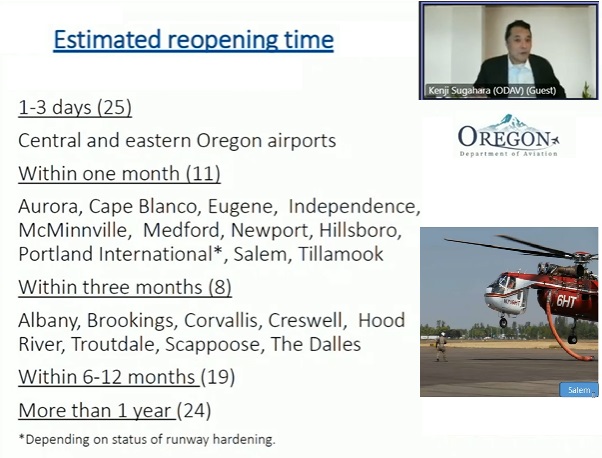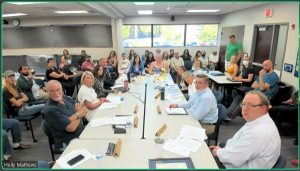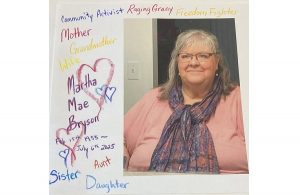Oregon will rely on airports after ‘The Big One’
9 min read
After the big earthquake, most transportation infrastructure will be damaged. To survive in the weeks and months afterwards, Oregonians will rely on local airports for emergency supplies. How fast can we get them up and running? On Jan. 12, legislators heard from Kenji Sugahara:
Kenji Sugahara (Oregon Department of Aviation): My name is Kenji Sugahara. I’m the director of the Department of Aviation. The title of our report is ‘The Day After: The Role of Oregon’s Airports in the Aftermath of the Cascadia Subduction Zone (CSZ) Megathrust Earthquake.’
[00:00:31] In Oregon, there’s 3.7 million people that live in the moderate-to-severe impact zones that are west of the Cascades, and most of them will survive the five minutes, five to seven minutes of shaking. But the question is: What comes afterwards?
[00:00:46] With a CSZ event, we can expect multiple critical infrastructures to fail. So you think about it: roads, rail, marine, all of them are going to suffer significant damage. And restoration is expected to take months or even years. Until the roads can be cleared, airports will be really the only access for many affected communities.
[00:01:10] An investment in airport resiliency may save the lives of millions of Oregonians and will play an important part of rebuilding after a CSZ event.
[00:01:23] So, to give you some background: HB 3058 required: a report to the legislature to focus on the role of airports after the massive earthquake event; report on airport resiliency; rank the airports; and offer an investment strategy for the legislature to consider.
[00:01:40] We have a really good system of airports already. We have 97 total airports, public use, that are already performing a lot of functions of resiliency and emergency management.
[00:01:50] For example, we have 15 that are air ambulance bases, 11 have based wildfire aircraft, three Coast Guard stations, 11 have control towers, seven have commercial airline service, and 14 have scheduled air cargo.
[00:02:05] After the earthquake, surface transportation links are going to be damaged. You think bridges, you look at the roads—those are buckled. You think of all the bridges that are going to fall into the Columbia River. Airports are really going to be the way, and air services are going to be the way to access these smaller communities.
[00:02:22] For most of West Oregon, the only access will be by air. Helicopters will play a major part, but in the U.S., only 5% of the aviation fleet are helicopters. The rest are fixed-wing aircraft.
[00:02:35] So, we learned some lessons from the past 10 years. The Oregon Resilience Plan listed 28 airports with the potential to maintain or quickly restore operational functions after a major earthquake. The way we look at it, most of the functional airports will be on the east side of the Cascades.
[00:02:54] The airports will need specialized equipment to become functional. A lot of these airports cannot afford to acquire equipment with their limited budgets. And federal transportation grants do not cover the cost of resiliency equipment or pavement.
[00:03:09] For airports to reopen after a Cascadia subduction zone event, there has to be at least one functional runway. This means the runways, as well as the parallel stub taxiways, like the apron, will need to be smooth and free of debris, have cracks, holes, and lips of no greater than three inches wide or deep, and be clear of obstructions.
[00:03:33] They have to have pavement markings that are clear and accurate, because people need to be able to see it from the air with the markings visible during the daytime operations. Nighttime operations will be very difficult. And if there was any subsidence, or if there was any coverage by water, then there has to be some rolling over the runway to make sure it can withstand the weight of the aircraft.
[00:04:00] And then airports must also have a way to communicate with aircraft.
[00:04:04] So estimated reopening time, we estimate that it’ll take one to three days for Central / Eastern Oregon airports to reopen.
[00:04:12] And then within one month, we’re looking at the airports, for example, Aurora, Cape Blanco, Eugene, Independence, McMinnville, Bedford, Newport, Hillsboro, PDX, Salem, and Tillamook, and the others will take even longer.
[00:04:27] Portland International, they are in the process of looking at hardening part of their south runway.
[00:04:33] So the priorities: Fuel storage is a big one because planes need fuel to fly in and out. Communications because planes need to communicate with the folks on the ground.
[00:04:44] Pavement because can’t land without pavement. Water and sanitation for the folks on the ground and lighting as well.
[00:04:51] So, Oregon has an Achilles heel, especially in regards to fuel. Most aircraft rely on petroleum fuels to operate. 90% of Oregon’s petroleum fuel is stored and distributed via this the critical energy infrastructure hub in Portland. And that’s going to face some major issues during the CSZ, just because of its location.
[00:05:12] Oregon’s airports have combined storage of 4.1 million gallons of aviation fuels. 90% of it is stored at airports in Western Oregon. And 70% of that is stored at one airport, Portland International Airport.
[00:05:28] So, I’ve mentioned pavement. Currently, no U.S. airport has a runway capable of remaining intact during a megathrust earthquake. Portland International is in the design phase of a project to harden the south runway. The current cost estimate right now, which is ballpark, was $200 to $300 million.
[00:05:49] Again, without a usable runway, Oregon’s airports will be limited to rotor wings only, so those are helicopters. Without a usable helipad or apron, even helicopters will not be able to land. Oregon needs to harden at least four runways in western Oregon, and at least one helipad at each airport.
[00:06:10] We do not have an estimate for how much it will cost, for the sheer reason that each individual airport is different in terms of its seismic resilience, in terms of what underlies the runways, and what conditions are around the airport.
[00:06:24] We’re hoping to see, eventually, a two-year pilot program funded at $10 million dollars per year for two years.
[00:06:31] What equipment would it fund? When we spoke with airports, when we spoke with emergency responders, this is a list that they came out with. And it’s very generic, generators, sweepers, communications, drones, forklifts, loaders, fuel storage, things that you would really need to reopen an airport.
[00:06:56] Rep. Paul Evans: I want to emphasize, the goal is not just to be able to provide sustainability operations, which is part of the package that I believe is being put forward, but also how it fits with national defense strategies is, that they would hopefully, if we can get the channel deepened enough, they would bring amphibious ships in and they would have V/STOL (vertical/short takeoff and landing) aircraft and helicopters using the facilities that we can get back into useful condition.
[00:07:26] And if we do this right, we will align our investments in our priorities along the training and activities of Air Force RED HORSE (Rapid Engineer Deployable Heavy Operational Repair Squadron Engineers) and the Seabees because they are trained at rapid airport repair.
And if we do this right, we can actually have exercises over the next several years and decades so that they actually can dial in specific airports so they know when it happens, where they’ll go, what they need, and what we’ve put in place for them to link into.
[00:07:55] So I’m excited about the work done. I think it puts the question before us. We can’t fix everything all at one time, but we can continue to develop a strategy that’s integrated and start at least putting one step at a time, generators and fuel storage, and those kinds of things we know we’ll need.
[00:08:14] Sen. Chris Gorsek: The tank farm situation in northwest Portland, right along the Willamette River: I think it’s going to take some 10 years to come up with a really good plan for that. But if we can do that sooner rather than later, that is a serious threat ecologically to the river.
[00:08:37] And of course also, if we can’t reinforce those tanks, it’ll be a serious loss for places like PDX. So I think it’s more of an emergency than came across, at least, yesterday.
[00:08:49] The other thing is, I know that PDX plans to upgrade their south runway. The one thing I worry about is they too are in a really bad earthquake zone in terms of the shaking that’s possible there and that, and then the levee holding back the river. I see that it’s a huge investment that we have there, and it’s hugely important. I just wonder how resilient you can make PDX, given its location. I think you have to try, but I think we’re always going to be maybe on the less successful side of that issue.
[00:09:33] Rep. Kevin Mannix: I think this report is very helpful in giving us a dynamic overview, and we also need to be creative and rethinking what resilience means. It doesn’t always mean paved runways. I landed at North Field on the island of Tinian many years ago, where we had a coral, crushed coral runway, which was a remnant of World War II.
[00:09:57] I’ve just looked up and I realize now the U.S. Air Force is now rebuilding all the runways on Tinian because of our need for additional air capability out there in the Pacific. But what I noticed more than 30 years after World War II, that this coral runway was still resilient. And I’m just, what I’m getting at, is: We should do some creative thinking about where some runways might be located, and no, we don’t have coral in Oregon, but some way of having runways which won’t necessarily be cracking up because they’re all hard paved surfaces.
[00:10:31] I just look forward to this conversation about what we can do, and I can envision a series of, I’ll call them emergency package runway systems, and we’ll begin this conversation. I think the report that we’ve received has been very helpful, and we’ll build from here.
[00:10:54] Rep. Paul Evans: You can actually build underneath the runway, anchor it in, so that it is actually usable afterwards. During Japan, we learned in 2011, we learned a lot of lessons with the Sendai experience. We can prioritize, and as Rep. Mannix said, we can be creative about how we do it. We can’t do it to everyone, but we can prioritize and make sure that we’re utilizing the materials needed for the kind of help we’re going to be getting.
[00:11:20] We may not need full runways in every place. We may can, again, through coordination with the military, we can actually focus on which areas may be more for V/STOL aircraft that don’t require an airport, and those that do, we reinforce and use modern technologies. The point is that we need to get a fire under the behind of everybody involved because the time is a-tickin’.
[00:11:43] Sen. Brian Boquist: I just want to point out to you that this is a work in progress. The work in progress is based on resources, and all of our op plans, including Op Plan 2013, is based on what the federal government gives us after the fact.
[00:11:58] This is going to be dependent when it happens on what the level of damage is and how fast the feds provide us resources.
[00:12:05] Just want to remind everybody we are the state of Oregon. So when everything shakes on the West Coast, you can figure out what the priority is going to be for us getting resources, versus places like Washington getting resources.
[00:12:19] So it is a work in progress. We should keep—we should take it as that. And for those of us who would like to see it improve, then we should make constructive criticisms and vote for the resources.
[00:12:30] Since the 19 years I’ve been here, I’ve heard almost every statement that’s been made here and we have yet to vote for any of those resources. So the director’s over there scrubbing around on his pencil paper and his stubby pen in his small office trying to figure out how to respond. This costs money, folks. Bottom line is: It’s money if you want to be prepared, because afterwards, wait in line for the federal government to come help us.
[00:12:52] John Q: Oregon legislators hope to coordinate with the military, whose Vertical / Short Take Off and Landing (V/STOL) aircraft don’t need a full runway. With joint exercises and creative use of runway materials, Oregon hopes to be in a better position to recover—instead of being stuck at the end of the line waiting for federal help.



